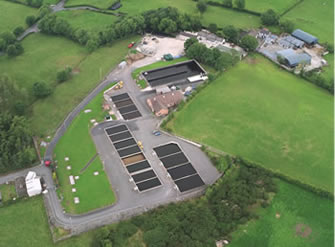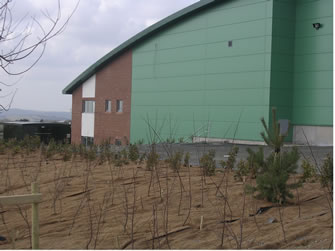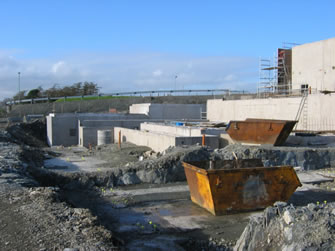Carran Hill Water Treatment Works |

82.1% |
Project Team:
Client: Northern Ireland Water Service
Design and Construction: Farrans (Construction) Ltd and Earth Tech Engineering (now AECOM)
 |
|
|
Project background
Carran Hill Water Treatment Works is situated on the outskirts of Crossmaglen in County Armagh. The works treats water from nearby Lough Ross, which historically has been plagued with algae problems. The existing works was reaching the end of its useful life and was struggling to deal with the level of algae being produced during the warmer summer months.
 |
|
In November 2004, the joint venture partnership of Farrans (Construction) Ltd and Earth Tech Engineering was awarded a £10m contract to construct a modern new treatment works that would produce high quality drinking water in line with the latest EU directives.
Procurement approach
The main design and build contract was based on NEC Option C (Target Cost Reimbursable) Conditions of Contract and from the outset a partnering and integrated supply chain approach was adopted as a means of achieving the optimum value solution.
Being the fifth in a series of water treatment works to be built as part of Water Service's Water Quality and Treatment Framework, the contractors at Carran Hill were able to adopt many of the lessons learnt from previous contracts. At the core of the Framework is innovation and best practice, with Water Service working with its supply chain to implement 'lean thinking' modern construction techniques to drive out waste in the design, construction and commissioning of water treatment facilities. At Carran Hill the latest construction and programme management initiatives (including open book accounting and continuous improvement) were adopted.
Key considerations
During construction work, the existing Carran Hill WTW was to remain in operation and as part of the new Carran Hill project, the old storage tanks were to be refurbished and a new clear water tank constructed. Only once the new works was fully commissioned was the old works to be decommissioned and demolished.
Environment-conscious design
The new Carran Hill WTW has been carefully designed so that its exterior blends in with the surrounding countryside. Curved roofs and green cladding are two of the aspects adopted to make the building more aesthetically pleasing in a rural environment. In landscaping the area, recommendations from the specially-prepared Ecology Report were incorporated into the landscape plan. In consultation with The Ulster Wildlife Trust, these included the construction of an otter holt down at the works' inlet pumping station.
 |
|
The detailed landscape plan centred on the planting of only native tree species, and during the contract the plan was revised to minimise import and export of material.
The project was designed to minimise the amount of concrete used. Cast in situ concrete tanks, usually used in the final stages of water treatment process, were replaced by stainless steel tanks that were fabricated off-site and set in place prior to the roof construction. The footprint of the building was substantially reduced and the finish levels reviewed to minimise the amount of rock excavation
 |
|
During construction, a percussion head was fitted to the rock hammer to reduce the noise generated during rock breaking.
Inside the works, the treatment process has been cleverly set up to allow all the water entering the plant to be recycled. This means that all water used during each of the treatment stages, i.e. water used to wash out filters, or water that is produced from the sludge process, is put back to the source of the works
The works utilises a robust four-stage treatment process. Extensive on line water quality instrumentation has been incorporated into the design to monitor and control the plant, allowing it to run automatically and with minimum operator intervention. The plant status is available via PC monitoring terminals located in the plant control room, with group and common alarms available for transfer to a telemetry station giving remote access and control of the plant.
'Green' construction
Emphasis was also placed on utilising recycled building materials. For example, the 300 tonnes of rebar used in the concrete construction was manufactured from scrap metal and the vast amount of plywood used in the shuttering process was sourced from forests belonging to certification schemes overseen by the PEFC Council (Programme for the Endorsement of Forest Certification Scheme).
Waste management practices employed on site included the segregation of all timber, rebar, and block/brick prior to removal to a local recycling facility. During construction all chemicals were stored in dedicated bunded areas and a special settlement tank was provided to contain any water pumped from excavations. To protect the Lough, floating booms were placed along the waterway.
 |
|
During Value Engineering workshops the team looked closely at energy efficiency and reducing the amount of power needed during operational hours. As a result, heating is only provided in the administration section of the building. The 'Power Correction Factor' target for the plant has been set at 0.98 and the standby generator can be used at peak times ('Peak Lopping') to generate electricity for the plant.
Construction innovations
The forward-thinking aspect of 'Constraint Management' was implemented right throughout the supply chain to assist completion by the 'Target Completion Date'. To achieve the best results, it was necessary to produce a fully integrated programme incorporating the design, procurement and construction phases and merging the entire civil and M&E elements and key supplier programmes into one schedule for monitoring and reporting purposes. This initiative allowed the designers and suppliers to plan their design and fabrication workload to suit their resources and capabilities and maximised the potential for off-site fabrication.
Key Performance Indicators & Respect for People Initiatives
Adoption of 'Respect for People' initiatives and benchmarking performance of key suppliers/ subcontractors on site with respect to site safety, quality, workforce satisfaction, working environment and team effectiveness, allowed continuous feedback and improvement measures to be incorporated during delivery of the project.
Community spirit:
Supply Chain Initiatives were established, allowing a substantial proportion of the monetary value of the project to be invested back into the community by sourcing and using locally-based material suppliers and subcontractors.
A high level of community interaction was maintained throughout the planning and construction stages and in support of community initiatives, the Carran Hill project team participated in a 10-mile sponsored walk, which raised £2,532 for a local charity. In November 2005, the team was also delighted to welcome children from the local primary school to the new works to give them an insight into how the new plant would run.
 |
